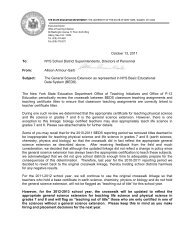ESL Learning Standards - Higher Ed - New York State Education ...
ESL Learning Standards - Higher Ed - New York State Education ...
ESL Learning Standards - Higher Ed - New York State Education ...
You also want an ePaper? Increase the reach of your titles
YUMPU automatically turns print PDFs into web optimized ePapers that Google loves.
DESCRIPTION OF ENGLISH LANGUAGE PROFICIENCY LEVELS<br />
In <strong>New</strong> <strong>York</strong> <strong>State</strong> there are four levels of English proficiency for the <strong>State</strong>’s<br />
LEP/ELLs: beginning, intermediate, advanced, and transitional. Students have traditionally<br />
been identified within one of these levels through scores on an English<br />
language placement exam as shown on the following chart:<br />
Levels of English Language Proficiency<br />
(Based on Percentile Score on a Standardized English Reading Test)<br />
1st percentile 10–13 20–23 30–33<br />
40th percentile<br />
Beginning<br />
Intermediate<br />
Advanced<br />
Transitional<br />
Mainstream<br />
(English)<br />
The chart above offers a recommendation for assigning students to levels of <strong>ESL</strong><br />
instruction using percentile scores on a standardized test of reading in English. It<br />
is important to recognize that the levels overlap because growth in all four language<br />
skills does not happen uniformly. School officials should decide on the<br />
placement of students scoring within the overlap zone. In such cases, indicators<br />
such as student age, maturity, grade level, students exposure to English, and<br />
achievement in both language and content areas in English and the native language<br />
should be considered in assinging students to specific levels.<br />
The following are general descriptions of the expected competencies of LEP/ELLs<br />
for each language skill area in each of the four proficiency levels.<br />
Beginning <strong>ESL</strong> Level (1st to 13th percentile)<br />
Listening: Students at the beginning level of <strong>ESL</strong> can comprehend simple statements<br />
and questions. They usually understand the main idea of extended but simple<br />
messages and conversations with some unfamiliar vocabulary and structures as<br />
well as cognates from their native language. Students at this level benefit from repetition,<br />
rephrasing, and nonverbal cues for comprehension. Students can comprehend<br />
language consisting of simple vocabulary and structures in face-to-face conversations<br />
with peers and familiar adults.<br />
Speaking: Students at this level can use level-appropriate strategies to initiate and<br />
respond to simple statements and engage in simple face-to-face conversations with<br />
more fluent speakers of the same age group. Students at the beginning level frequently<br />
make themselves understood by using repetition and circumlocution.<br />
Reading: Students at the beginning <strong>ESL</strong> level can understand simple material for<br />
informative or social purposes. They can understand the essential content of short,<br />
general, public statements and standardized messages. They can comprehend the<br />
main ideas of simple informative materials written for native English speakers,<br />
Introduction 3
















